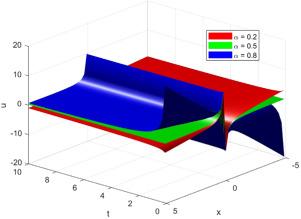(2+1)-dimensional Burgers equation with a Caputo fractional derivative:列对称分析、最优系统、精确解和守恒定律
IF 4.6
2区 物理与天体物理
Q1 PHYSICS, MULTIDISCIPLINARY
引用次数: 0
摘要
本文应用李群方法分析了带有卡普托分数导数的 (2+1)-dimensional Burgers 方程。研究了方程的无穷小生成器。然后,利用方程的列点对称性,构建了一个一维最优系统。随后,在最优系统的框架内,利用不变子空间法和均质平衡法对方程进行对称简化并确定原始方程的精确解。在将方程简化为 (1+1) 维分数微分方程的过程中,刻意避免使用复杂的 Erdélyi-Kober 分数导数算子。取而代之的是利用简单的变换得到低维分数微分方程。最后,基于非线性自相接的概念,得到了分数微分方程的守恒定律。本文章由计算机程序翻译,如有差异,请以英文原文为准。

(2+1)-dimensional Burgers equation with a Caputo fractional derivative: Lie symmetry analysis, optimal system, exact solutions and conservation laws
In this paper, the Lie group method is applied to analyze the (2+1)-dimensional Burgers equation with Caputo fractional derivative. The infinitesimal generators of the equation are investigated. Then, using the Lie point symmetry of the equation, a one-dimensional optimal system is constructed. Subsequently, within the framework of the optimal system, the equation is symmetrically simplified and the exact solutions of the original equation are determined using the invariant subspace method and the homogeneous balance method. In the process of simplifying the equation to a (1+1)-dimensional fractional differential equation, it is deliberately avoided to use complex Erdélyi-Kober fractional derivative operator. Instead, a simple transformation is utilized to obtain a low-dimensional fractional differential equation. Finally, based on the concept of nonlinear self-adjointness, the conservation laws of the fractional differential equation are obtained.
求助全文
通过发布文献求助,成功后即可免费获取论文全文。
去求助
来源期刊

Chinese Journal of Physics
物理-物理:综合
CiteScore
8.50
自引率
10.00%
发文量
361
审稿时长
44 days
期刊介绍:
The Chinese Journal of Physics publishes important advances in various branches in physics, including statistical and biophysical physics, condensed matter physics, atomic/molecular physics, optics, particle physics and nuclear physics.
The editors welcome manuscripts on:
-General Physics: Statistical and Quantum Mechanics, etc.-
Gravitation and Astrophysics-
Elementary Particles and Fields-
Nuclear Physics-
Atomic, Molecular, and Optical Physics-
Quantum Information and Quantum Computation-
Fluid Dynamics, Nonlinear Dynamics, Chaos, and Complex Networks-
Plasma and Beam Physics-
Condensed Matter: Structure, etc.-
Condensed Matter: Electronic Properties, etc.-
Polymer, Soft Matter, Biological, and Interdisciplinary Physics.
CJP publishes regular research papers, feature articles and review papers.
 求助内容:
求助内容: 应助结果提醒方式:
应助结果提醒方式:


